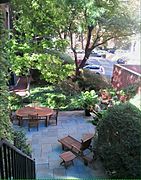
Lakeview, also spelled Lake View, is one of the 77 community areas of Chicago, Illinois. Lakeview is located in the city's North Side. It is bordered by West Diversey Parkway on the south, West Irving Park Road on the north, North Ravenswood Avenue on the west, and the shore of Lake Michigan on the east. The Uptown community area is to Lakeview's north, Lincoln Square to its northwest, North Center to its west, and Lincoln Park to its south. The 2020 population of Lakeview was 103,050 residents, making it the second-largest Chicago community area by population.

Edgewater is a lakefront community area on the North Side of the city of Chicago, Illinois six miles north of the Loop. The most recently established of the city's 77 official community areas, Edgewater is bounded by Foster Avenue on the south, Devon Avenue on the north, Ravenswood Avenue on the west, and Lake Michigan on the east. Edgewater contains several beaches that residents enjoy during the late spring, summer, and early autumn. Chicago's largest park, Lincoln Park, stretches south from Edgewater for seven miles along the waterfront, almost to downtown. Historically, Edgewater was the northeastern corner of Lake View Township, an independent suburb annexed by the city of Chicago in 1889. Today, the Uptown community is to Edgewater's south, Lincoln Square to its west, West Ridge to its northwest and Rogers Park to its north.

Strathmore, or Strathmore "By the Park" Subdivision, is a neighborhood in the southwest of Syracuse, New York, United States. It is a mostly residential neighborhood that has many houses from the early and middle of the twentieth century.

The Washington Avenue Historic District is located in Downtown West, St. Louis, Missouri along Washington Avenue, and bounded by Delmar Boulevard to the north, Locust Street to the south, 8th Street on the east, and 18th Street on the west. The buildings date from the late 19th century to the early 1920s. They exhibit a variety of popular architectural styles of those years, but most are revival styles or in the commercial style that would later come to be known as the Chicago School of architecture. Most are large multi-story buildings of brick and stone construction, built as warehouses for the St. Louis garment district. Many have terra cotta accents on their facades. After World War II, the decline in domestic garment production and the preference for single-story industrial space led to many of the buildings being vacant or underused due to functional obsolescence.

This is a list of properties and districts in Illinois that are on the National Register of Historic Places. There are over 1,900 in total. Of these, 85 are National Historic Landmarks. There are listings in all of the state's 102 counties.
This National Park Service list is complete through NPS recent listings posted December 15, 2023.
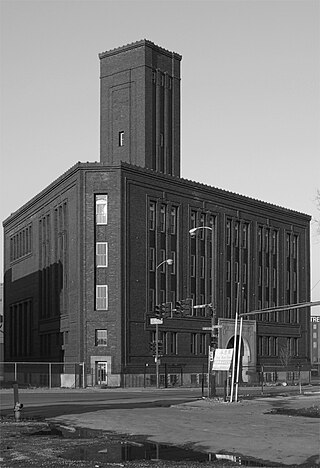
The Schoenhofen Brewery Historic District is centered on the former site of the Peter Schoenhofen Brewing Company at 18th and Canalport Avenue in the Pilsen neighborhood of Chicago, Illinois.
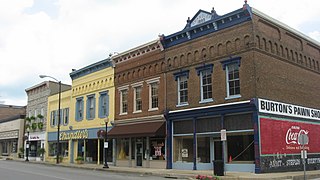
The Campbellsville Historic Commercial District comprises a collection of about 20 buildings in downtown Campbellsville, Kentucky, a 200-year-old city. The district is listed on the National Register of Historic Places.
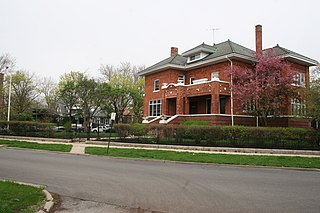
The Ravenswood Manor Historic District is a historic district in the Albany Park community area of North Side, Chicago, Illinois. It is bordered by the Chicago River on the East, and by the alley south of Lawrence Avenue on the North, Sacramento Avenue on the West, and the alley North of Montrose Avenue on the south.

Prairie Avenue is a north–south street on the South Side of Chicago, which historically extended from 16th Street in the Near South Side to the city's southern limits and beyond. The street has a rich history from its origins as a major trail for horseback riders and carriages. During the last three decades of the 19th century, a six-block section of the street served as the residence of many of Chicago's elite families and an additional four-block section was also known for grand homes. The upper six-block section includes part of the historic Prairie Avenue District, which was declared a Chicago Landmark and added to the National Register of Historic Places.

The Uptown Broadway Building is a historic three-story building at 4703–4715 North Broadway in Uptown, Chicago. Built in 1926, it was designed by Walter W. Ahlschlager and is known for its ornate terra-cotta facade, depicting ancient gods, rams' heads, shields, helmets, birds, fruits, and trophies. Lynn Becker of the Chicago Reader has called the exterior "a riotous, Spanish-baroque-inspired hallucination". According to unconfirmed local legends, Al Capone operated a speakeasy in the building's basement.

W. H. Winborne House is a historic home located at Conway in Horry County, South Carolina. It was built about 1925 and is a brick 1+1⁄2-story, rectangular plan, cross-gable-roofed American Craftsman-style residence. The façade features a broad peaked gable over an integral porch which wraps three sides.
There are 96 sites in the National Register of Historic Places listings in North Side Chicago — of more than 350 listings within the City of Chicago, in Cook County, Illinois.
Oscar Cobb was an American architect of theaters and more. Several of his works are listed on the U.S. National Register of Historic Places.

William Dubois (1879–1953) was an American architect and politician. He was a prolific architect in Wyoming and nearby states, and served five terms in both houses of the Wyoming Legislature.

The Pittsburgh-Des Moines Steel Company, and often referred to as Pitt-Des Moines Steel or PDM was an American steel fabrication company. It operated from 1892 until approximately 2002 when its assets were sold to other companies, including Chicago Bridge & Iron Company. The company began as a builder of steel water tanks and bridges. It also later fabricated the "forked" columns for the World Trade Center in the 1960s, and was the steel fabricator and erector for the Gateway Arch in St. Louis. A number of its works are listed on the National Register of Historic Places.
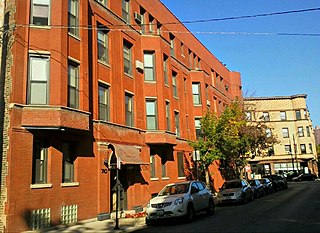
The Lakeview Historic District is a historic district on the north side of the city of Chicago, Illinois.

The Downtown Aledo Historic District is a national historic district located in downtown Aledo, Illinois. The district includes 75 contributing buildings and a park. The majority of the buildings are commercial structures, but the district also includes the city's Chicago, Burlington and Quincy Railroad station and both the city's and Mercer County's major government buildings. Development in the district began in the 1850s, and the oldest surviving buildings date from the following decade. The district includes examples of many prominent American architectural styles from the mid-19th century onward; the most prevalent styles are Classical Revival, Romanesque Revival, and Italianate.

The William and Sue Damour House is a historic house located at 1844 Second Avenue SE in Cedar Rapids, Iowa.
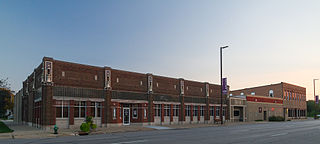
The West Side Third Avenue SW Commercial Historic District is a nationally recognized historic district located in Cedar Rapids, Iowa, United States. It was listed on the National Register of Historic Places in 2014. At the time of its nomination it consisted of 10 resources, which included seven contributing buildings and three non-contributing buildings. Cedar Rapids was platted on the east bank of the Cedar River as Rapids City in 1841, and it was incorporated in 1849. Kingston was established on the west bank of the river in 1852, and it was annexed by Cedar Rapids in 1870. The streets were laid out parallel and perpendicular to the river, which flowed from the northwest to the southeast. The Chicago, Iowa & Nebraska Railway, later the Chicago & North Western Railway, was the prominent railroad on the west side of town. The first bridge across the river at Third Avenue was built in 1871. The current bridge was completed in 1912. Prior to a bridge, Rapid City and Kingston were connected by a ferry operated by David W. King, the founder of Kingston.
The Downtown Wellington Historic District, in Wellington, Kansas, is a 21 acres (8.5 ha) historic district which was listed on the National Register of Historic Places in 2007.





